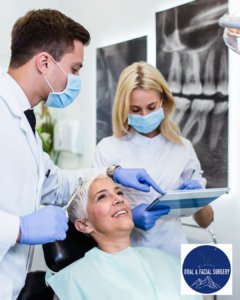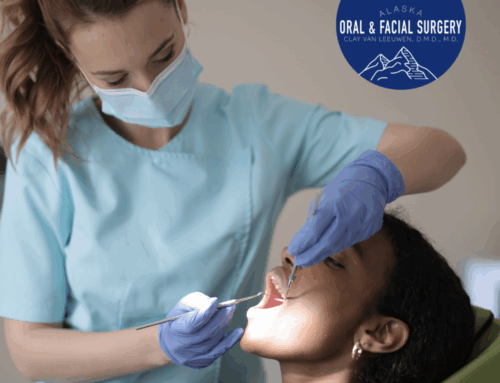Impacted Canines: What You Need to Know

At Alaska Oral and Facial Surgery, we understand the vital role that canine teeth—also known as cuspids or “eye teeth”—play in your dental health. Positioned at the corners of the dental arch, these teeth are essential for biting, tearing food, and maintaining proper dental alignment. However, when canines fail to emerge correctly, a condition known as impacted canines can develop, potentially leading to discomfort, misalignment, and risk to your overall oral health. Understanding the causes, risks, and treatment options for impacted canines is key to ensuring a healthy, functional smile.
Causes of Impacted Canines
Several factors can lead to the impaction of canine teeth:
1. Insufficient Space
A common reason for impaction is the lack of adequate space in the dental arch. When there’s overcrowding, the canine tooth may lack the room needed to emerge correctly, leading to impaction.
2. Prolonged Retention of Baby Teeth
If primary (baby) teeth do not fall out on schedule, they can obstruct the path of the emerging adult canines, resulting in impaction.
3. Abnormal Growths or Extra Teeth
The presence of extra teeth (supernumerary teeth) or growths can block the eruption pathway of the canine teeth, causing them to become impacted.
4. Genetic Factors
Genetics can also play a role, with some individuals more predisposed to dental impactions due to inherited traits affecting jaw size or tooth development.
Signs and Symptoms
-
Delayed Eruption: If a child has a canine tooth that hasn’t emerged by age 13, it may be impacted.
-
Swelling or Tenderness: Impacted canines can cause gum swelling or discomfort in the affected area.
-
Misalignment: Adjacent teeth may shift or tilt due to the pressure exerted by the impacted tooth.
-
Prolonged Retention of Baby Teeth: Primary canines remaining in place longer than usual can signal impaction.
Regular dental check-ups are essential for early detection and management of such issues.
Potential Complications
Untreated impacted canines can lead to several complications:
1. Cyst Formation
A fluid-filled sac, or cyst, can develop in the soft tissue around the impacted tooth, potentially causing bone loss or damage to surrounding teeth.
2. Root Resorption
The impacted tooth can exert pressure on neighboring teeth, leading to the resorption (dissolving) of their roots, compromising their stability and increasing the risk of tooth loss.
3. Infection
Impacted teeth can become a focal point for accumulation of bacteria, leading to infections that may spread to the surrounding tissue.
How is it Diagnosed?
Early and accurate diagnosis is crucial. A thorough dental examination can identify signs of impacted canines, such as delayed eruption or misalignment. To confirm the diagnosis, radiographic imaging, including panoramic X-rays, is used to pinpoint the exact position of the impacted tooth and assess for any potential damage to surrounding structures.
Treatment Options
Addressing impacted canines typically involves a multidisciplinary approach involving orthodontics, oral surgery, and general dentistry:
1. Orthodontic Intervention
Orthodontic therapy can create space in the dental arch using braces or aligners, facilitating the natural eruption of the impacted canine.
2. Surgical Exposure and Bonding
When natural eruption isn’t a feasible option, a minor surgical procedure is done to open the gum tissue expose the impacted tooth. An orthodontic bracket is then attached, allowing guided movement into its proper position.
3. Extraction
In cases where the impacted canine poses risks to oral health or cannot be properly aligned, extraction may be necessary. Subsequent orthodontic treatment can address any resulting gaps or misalignments.
Preventive Measures
While not all cases are preventable, certain measures can reduce the risk of impaction:
-
Regular Dental Visits: Routine check-ups facilitate early detection of potential eruption issues.
-
Timely Intervention: Addressing overcrowding or early loss of primary teeth promptly can prevent impaction.
-
Proactive Monitoring: For individuals with a family history of dental impactions, proactive monitoring and imaging may be advisable.
The Role of Alaska Oral & Facial Surgery Center
At Alaska Oral & Facial Surgery Center, Dr. Clay Vaan Leeuwen specializes in diagnosing and treating impacted canines. Our comprehensive approach ensures:
-
Personalized Treatment Plans: Tailored strategies that align with each patient‘s unique needs.
-
Advanced Surgical Techniques: Utilizing state-of-the-art methods and technology to ensure optimal outcomes and patient comfort.
-
Collaborative Care: Working closely with our team to provide cohesive treatment.
Meet Dr. Clay Van Leeuwen
Dr. Van Leeuwen brings extensive expertise in oral and maxillofacial surgery. His commitment to patient-centered care ensures that each individual receives the highest standard of treatment, particularly in managing complex cases like impacted canines.
Don’t Let Impacted Canines Impact Your Smile!
If you or a loved one suspects an impacted canine, don’t wait. Schedule an appointment with Dr. Van Leeuwen at Alaska Oral & Facial Surgery Center. Our team is dedicated to restoring and enhancing your smile‘s health and aesthetics. Give us a call at (907-802-4098) to book an appointment.

